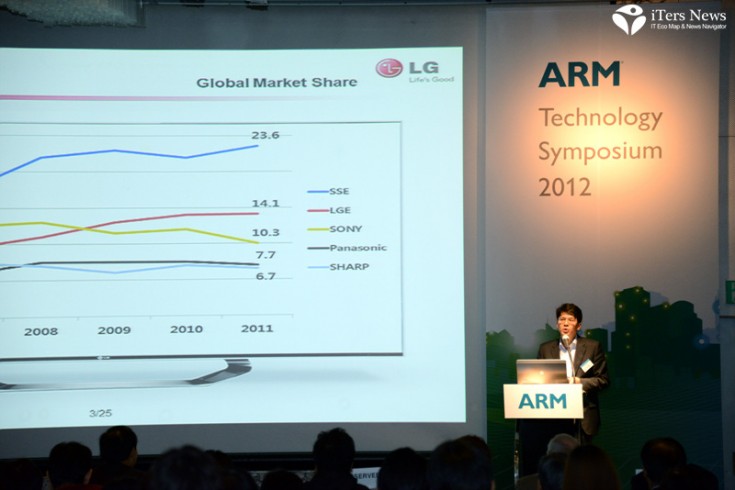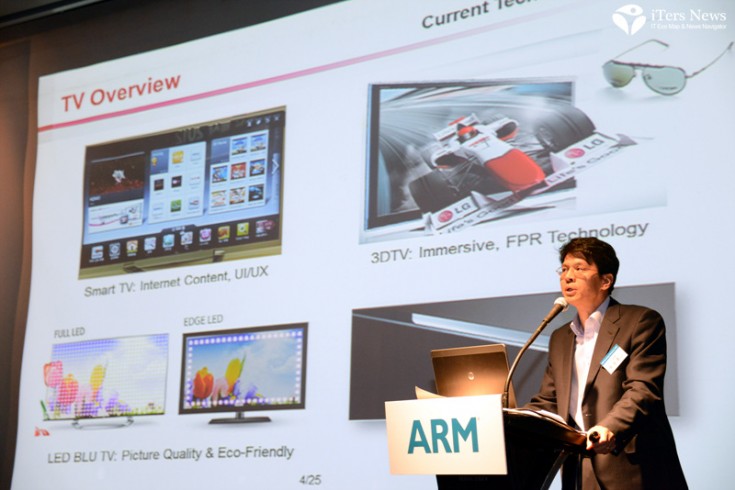(iTers News) – Smart TVs of today have a long way to go before they are as smart as smart phones and tablet PCs.
Running on a CPU and OS software platform, smart TVs have become Internet-capable to download tons of apps and movies from online VOD movie service sites like Netflix and Lulu as fast as a PC.
Going smart
Built with vision and motion sensors, they also become intelligent enough to listen to and understand what people speak to, interacting with users with a command of voice.
Yet, they have to go an extra mile to work as a smart home entertainment hub to control and connect all smart devices in the home to share and render video-rich contents.
“Going smart is an unstoppable trend on TVs. People want to download, or bring up video games and other video–heavy apps from an array of neighboring smart devices to play them on a large TV screen with a more intuitive user interface like gesture-recognition. To power these apps and game titles, the smart TV SOC will likely evolve to match PCs and smart phones in the computing power of CPU and GPU, incorporating more and more of processor cores, “ Choi, Seoung-jong, vice president with LG Electronics’ Systems IC Lab.
As the name of the SOC, or system on a chip, the smart TVs are indeed just a simple replica of the SOC solution. LG’s L9 smart TV SOC is a crystal ball of how smart TVs have evolved over the last two years and which smart add-on features they will incorporate further going forward.
Extra miles to go
Built on ARM Cortex-A9 dual core, L9 SOC is now underlying all of LG’ Cinema 3D Smart TV product line-up.
The L9 chip incorporate about 30 analog mixed signal IPs like high channel bit AD converters for demodulators and 3D channel rate converters as well as analog and digital RF signal and composite video signal IPs.
The analog mixed signal IPs include ADC/DAC, system PLLs, high speed video interfaces like HDMI 1.4, LVDS Vx1, connectivity interfaces like USB 2.0 and 3.0 and SATA as well as PCI Express, and memory interfaces.
For video and audio processing, it has also built-in HD video encoder and decoder chips as well audio codecs and sound engines and picture quality enhancement engines.
TVs have gone smart. So have SOCs. Compared with its digital TV front-end chip of 2002 codenamed HD-2 that incorporates just 3.8 million transistor gates for video and audio processing, the L9 SOC has about 80 million gates for incorporating a whole system of TVs.
“The HD-2 was fabricated with 0.18 micron technology and has an external CPU. To develop the chip, just tens of engineers worked on it pattern designs. Yet, we used 40nm technology to fabricate the L9 and had several hundreds of chip designers to work on the chip”, vice-president Choi said.
More than 20 times gain in transistor gates
What is core at the L9 chip is LG’s proprietary picture quality enhancement engine.
LG crammed analog noise reduction, de-interlacer, scaler, FRC, or frame rate converter for 2D HD TVs as well as 2D/3D converter, crosstalk reduction, 2D/3D frame rate converter for 3D pictures into the L2 chip.
The up conversion of from 2D to 3D engine and addition of built-in CPU and GPU is a prime example of how TVs have gone smart, he added.
The L9 chip has also DDR3 DRAM chip as its external memory chip to buffer data from external sources to its built-in CPUs and other peripherals like the picture quality engine.
Software platform is as crucial part of LG’s smart TV product line-up as L9. LG has built its own home-grown Linux kernel-based OS platform that comes complete with SOC driver audio and video media frame work, graphic libraries like OpenGL, flash engines, and Web browser.
The integration of CPU and GPU into traditional encoder-and decoder-based TV SOC in turn has been spurring big shake-up in the TV SOC market, consolidating many front-end and back-end TV SOC makers into quiet a few fabless SOC chip makers like MediaTek and MStar of Taiwan.
LG sees huge potentials on TV SOCs
While big titans like NXP of the Netherlands and Micronas of Germany faded into the background, MStar and MediaTek have made their name as rising stars, collectively representing more than 60% of worldwide market.
As smart TVs are getting more sophisticated, however, the competitive landscape is being redrawn again between the two fabless SOC makers and system makers like Samsung Electronics and LG Electronics.
To keep up, or spearhead the way that TV are going smarter and smarter, Samsung and LG are investing huge money to develop their own TV SOC solutions.
The world's two largest TV makers have their own captive markets to get early ans secure returns on their investments on SOC design and fabrication.
As photo mask costs and R&D investments are now going through the roof, this early and sure-return on investments would give them a leg up in leading the SOC development cycle, helping them to threaten to make a big dent into the dominance of the two Taiwanese fabless chip makers.
"Apple and Samsung showed how they have taken advantage of their economies of scale in global smartphone and tablet PC markets. The same will be true of TV SOC market. As TVs get a lot smarter, so do SOC solutions. To win in the race, we have to be a first mover, leading the development cycle, " said vice president Choi, Seoung-jong with LG Electronics.
While LG has no sale record in this market, backyard arch-rival Samsung Electronics already claimed about 6.2% share of worldwide TV SOC market in the 4th quarter of 2011, according market research firm Display Search.
Videos and Photos by JH BAE




